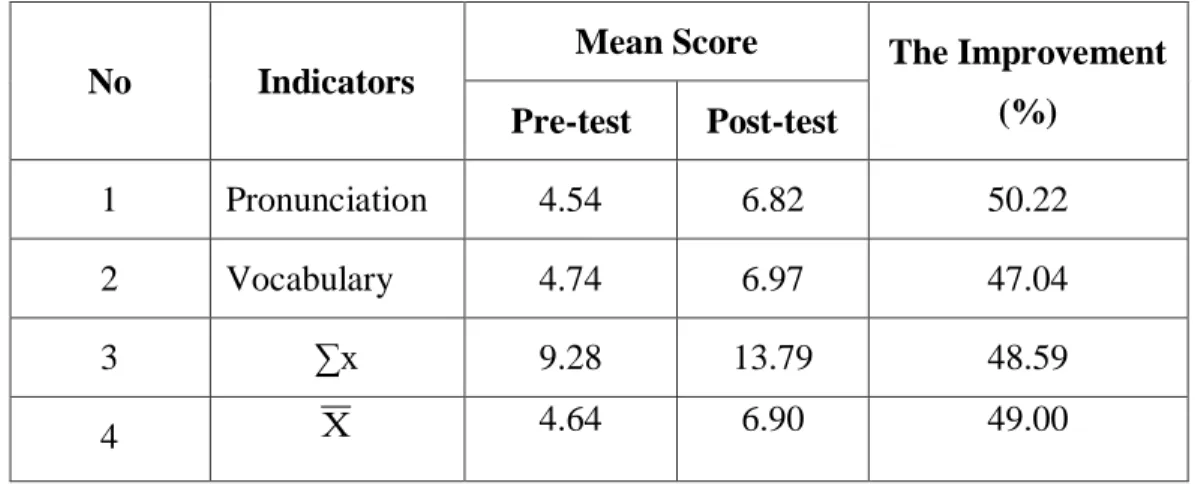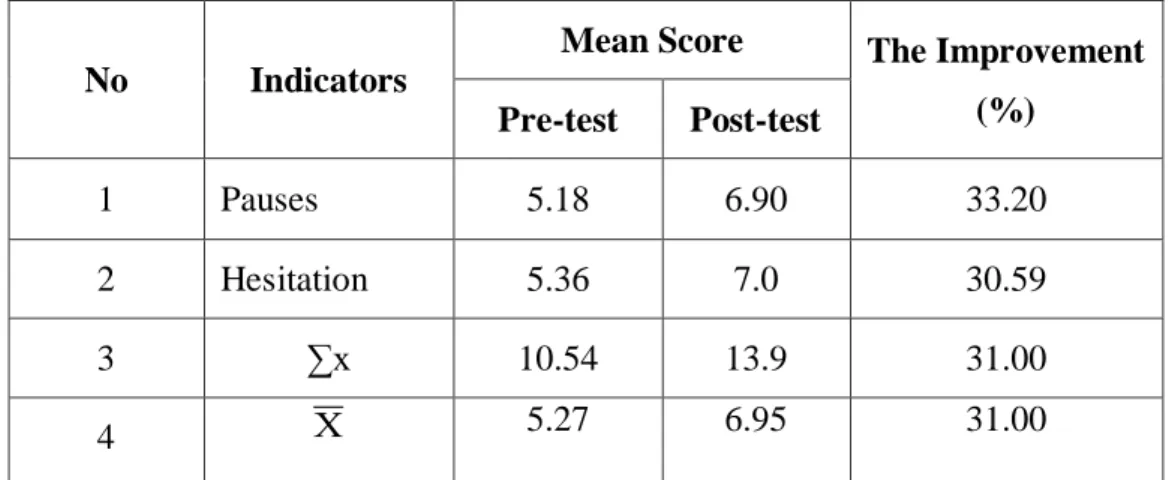Principal of SMP Negeri 8 SATAP Dra. Sulaeha Saleh, All third year teachers of SMP Negeri 8 SATAP help to carry out this thesis. Finally, the researcher realized that this thesis has still not been prefect yet and still needs more suggestions and critics, so there is a strong need for more improvements to this thesis.
Background
There are some problems in teachers' practice and method, why students find it difficult to say English words in class. The teacher should motivate the students to learn English in the classroom and create the teaching method.
Problem Statement
Research Objective
Significant of Study
Scope of the Research
- primary positions of the feet
- models of position and gesture, showing how to use the arms and hand There are fifteen systematic gestures in appendixes of the right arm, with
- The Voice
- The Rule for expressing
Pronunciation of the letters of the alphabet, as well as related, as in the pronunciation of words. According to Griffith the Elements of language are divided into three classes, they are
Gesture
Expresses with speed, interruption, noise, hardness and diffidence. The neck extended and the head forward, often nodding menacingly and shaking, against the object of the passion. It includes symbolic gestures or pantomime gestures used in the absence of speech, gestures where the hands and mouth contribute to the overall meaning of a message, deictic pointing, culturally bound emblems such as the "ok" gesture, and finally. Teacher gestures can also have a trickle down effect, which can lead to more student gestures.
Concept of Speaking
Elements of Speaking
Accuracy
According to Marcelo, Misrawati (2012:10) defines that one can be considered to have a good use of vocabulary if the vocabulary produced is broad (lack of repetition) or suitable for a particular dialogue or speech situation. Words that we vaguely recognize, but are not sure of the meaning, we never use either in speech or in writing. It includes consideration of how sentences are linked, how sentence patterns change in word order and omit elements of structure, and also some aspects of discourse prosody.
Briefly, the researcher's statement concludes that the function or element y has one goal or the same goals as speaking ability. From a functional perspective, Goldman-Eisler (1968) proposed that filled and silent pauses reflect different internal processes: filled pauses reflect affective states such as anxiety and silent pauses correspond to the cognitive difficulty of the task involved. Hesitation phenomena such as fillers are most likely to occur at the beginning of an utterance or sentence, presumably as a consequence of the larger.
Another trick is to imagine a letter "T" on the listener's face, with the crossbar an imaginary line crossing the eyebrows and the vertical line coming down the middle of the nose.
Conceptual Framework
Research Design
- Treatment
- Post-test
- Alternative Hypothesis (H1)
- Null Hypothesis (H0)
- Sample
The teacher motivated the students and explained what they were going to do. Then the teacher led the students to repeat the words, helped and asked them to find out the meaning of the word in the dictionary. After completing their task, the teacher as the main character was given a voice test where the principle of diction was applied in the students' individual table during standing practice.
Then the teacher asked the students to follow the teacher to stand up and repeat the utterance and poetry using a gesture in eloquence while speaking (give an example gesture from the book text). Notes: The teacher gave the students a topic for each meeting, The topics as follows:. After treatment, the post-test was given and it aimed to find out the students. performance, the post-test is used to know the students' speaking ability after teaching and learning process by using gestures in eloquence.
Students who spoke accurately in English included pronunciation and vocabulary. pronunciation; knowing how to speak the language.
Research Instrument
The first class consists of 31 students, the second class consists of 24 students and the third class consists of 22 students, the total number of students was 77 students. A purposive sample is one that is selected on the basis of knowledge of a population and the purpose of the study. The goal is to make the study easier to assemble and also practical.
The researcher will use the video recorder as a supporting instrument to measure the students' speaking ability.
Procedure of Collecting Data
There is no evidence that you have mastered any of the languages and areas practiced in the course. Education of professional vocabulary to discuss special interest; the general vocabulary allows discussion of any non-technical topic under some circumstances. The choice of words is sometimes imprecise, the limitations of the vocabulary prevent the discussion of some common professional and social topics.
Speaks with little hesitation, but usually does not interfere in communication Average 2 Speaks with little hesitation, which often.
Technique of Data Analysis
- Mean score
- Computing the frequency and the data percentage of the students score by using the following formula
- Finding the development of the speaking skill, by using the percentage technique as follow
- To find out the difference between the pre test and post test, the researcher calculated the value of the test used the formula as a follow
Hesitates too often when speaking, often interfering with communication. Adapted from Longman, 2005) The correct answer from the students. Calculated the average score of the students in both the pre- and post-test using the formula followed. X (Gay) To find out the difference between the pre-test and the post-test, the researcher calculated the value of the test and used the formula as follows: The researcher calculated the value of the test and used the formula as follows.
The results present here what is achieved from the activities carried out during the teaching process of speaking using gestures in elocution and the students' learning outcome, and the discussion focuses on the activities in the teaching of speaking skills through the use of gestures in elocution.
Findings
The improvement of students’ fluency
The improvement in students' fluency handling of pauses and hesitations in third-year students at SMP Negeri 8 SATAP Kec, Liukang Tupabbiring can be clearly seen in the following table. It is indicated that the students' performance during breaks improves (33.20%) and the score is higher than before. While the mean score for hesitation before using gestures in elocution in pretest is 5.36.
It is indicated that the students' improvement in hesitation is 30.59% and the score is also higher than before. Based on the results, it can be concluded that the use of gestures in the elocution method is effective in improving students' speaking skills in the term fluency (31%).
The improvement of students speaking ability
The student's improvement in the speaking ability of the text is taken from the students' average scores. Based on the data in the table above, the students' form accuracy on the pre-test is 4.63, which is different from the students' score on the post-test (6.90). While the student's fluency score on the pre-test is 5.27, which is different from the students' post-test score (6.95), this means that there has been an improvement (31%) in the students' fluency.
Hypothesis Testing a. t-test of Value
It means that there is a big difference between the speech of the students in the classroom before and after the implementation of the use of gesture in elocution in the speaking process of the third grade students of SMP Negeri 8 Satap Kec. If the t-test result is lower than the t-table value, the null hypothesis (H0) will be rejected, and if the t-test result is higher than the t-table value, the alternative hypothesis (H1) will be accepted. The null hypothesis (H0) is rejected and the alternative hypothesis is accepted (H1). Therefore, there is a significant difference between the pretest and posttest score of students in speaking ability through the implementation of the use of gesture in elocution.

Discussion
The improvement of the Students’ Accuracy in speaking
A connection is made between the fact that there is a performance in the average score of students on the pre- and post-test. In other words, in the pre-test, the students think that the score is low and the category is bad because they always make the mistake of saying it. From this, the researcher concludes that the pre-test of the student category is classified as poor and the students in the post-test achieve a performance that is classified as fairly good.
However, the improvement of students' vocabulary can be said to be a success, where the result of students' improvement is 47%. By practicing in class how to express words that have meaning, students can remember which words they used to express themselves when speaking. From the explanation above, that there is an improvement of students in pronunciation and vocabulary in the term of accuracy where the improvement of students' accuracy point is 49%.
This suggests that the use of gestures in speaking method is effective in improving students' speaking accuracy.
The improvement of the Students’ Fluency in speaking
Based on the results above using the use of gesture in elocution in the class, the data is collected through the test, as explained in the previous section on results, it shows that the students' speaking ability in terms of fluency is significantly improved. It is supported by the average score after testing students' speaking ability in fluency is higher than pre-test. Therefore, the use of gesture in fluency is effective in improving students' speaking ability in fluency and can help language learners to build up.
This indicated that eloquence is the study of vocal delivery. It can be said to include both a science and an art.
The improvement of the students’ speaking ability
As explained above, the mean score in the pretest improved in the posttest. It is indicated that the use of gestures in eloquence helps to improve students' speaking ability. The students are stimulated to speak without feeling reticent, boring and again anxious (more hesitation and pauses.
The researcher thus concludes that there is a significant improvement in the speaking skills of the students in SMP Negeri 8 SATAP kec Liukang Tupabiring. By seeing that the speaking skills of the students improve, it is concluded that the use of gestures in the diction improves the speaking skills of the students.
Conclusions
Suggestions
Accuracy
Fluency
Assessment score for students' speaking ability (final result) in pretest and posttest.
Mean score of the students’ accuracy in pretest
Mean score of the students’ posttest
The percentage of students’ improvement in accuracy
Calculating of t-test value 07
Mean score of the students’ fluency in pretest
The percentage of students’ improvement in Fluency
Calculating of t-test value 7
Mean score of the students’ pretest
The percentage of students’ improvement
The classification of the students' pre-test and post-test in final score of speaking skill.



